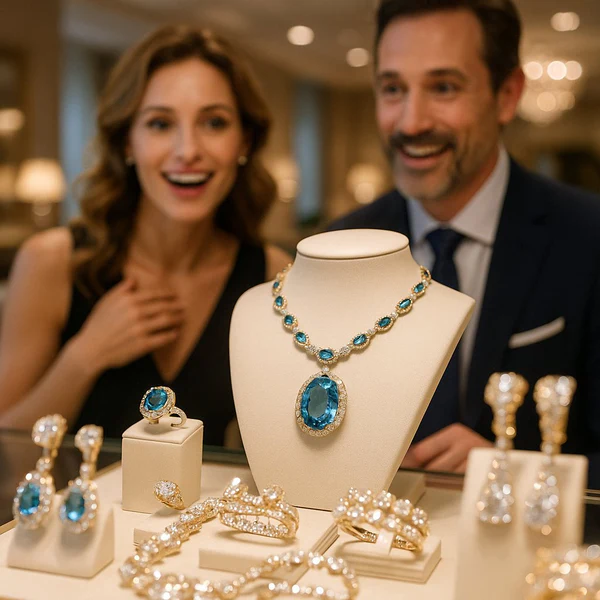Introduction: A Gemstone with Staying Power
In a world where trends come and go, topaz stands as a symbol of enduring elegance. Celebrated for its radiant beauty and spiritual depth, this gemstone has been a favorite across centuries—revered by ancient civilizations, embraced by royalty, and cherished by modern luxury collectors. Today, Topaz Jewelry continues its rise, offering a captivating blend of history, symbolism, and refined design.
But how did topaz become such a timeless favorite? The journey of this brilliant stone through the ages tells a story of power, prestige, and transformation—one that reflects not only the stone’s physical qualities but also its evolving meaning in human culture.
Ancient Beginnings: Mystical Origins and Royal Ties
The story of topaz begins in antiquity. The earliest known sources trace the gem back to the Red Sea’s Topazios Island—now called St. John’s Island—where miners discovered luminous yellow crystals thousands of years ago. This is where topaz earned its name, and its mythos was born.
In Ancient Egypt, topaz was believed to carry the glow of the sun god Ra, offering vitality and protection to its wearer. Egyptian royalty adorned themselves with the gemstone as a symbol of divine favor and personal strength. Meanwhile, in Ancient Greece, topaz was considered a talisman for warriors—granting courage and shielding them from harm.
Its spiritual symbolism varied across regions, but topaz consistently emerged as a stone of power, clarity, and healing.
From Renaissance to Regency: Topaz Finds Its Place in European High Society
As trade routes expanded during the Renaissance, topaz began making appearances in the courts of Europe. Jewelers in Italy, France, and England fashioned it into ornate pendants and rings, often set in gold and surrounded by enamel or pearls. It was treasured not just for its beauty, but for its perceived ability to calm tempers, dispel magic, and restore mental clarity.
By the 18th and 19th centuries, blue topaz rose in popularity among aristocrats. Its calming hue made it a favorite in Georgian and Victorian-era jewelry—particularly in England and Russia. Blue topaz was associated with communication, loyalty, and serenity—qualities that resonated with poets, thinkers, and social elites alike.
Topaz was also frequently used in commemorative jewelry during this time. Lockets, brooches, and mourning pieces often featured the gemstone as a way to honor loved ones, highlighting its emotional and symbolic importance in both personal and public life.
The Birthstone Boom: Topaz in the 20th Century
In the early 1900s, topaz experienced another wave of popularity—this time with the rise of the modern birthstone system. Topaz was officially named the birthstone for November, which catapulted it into the mainstream. As jewelers promoted the idea of personalized gemstone gifts, topaz became one of the most gifted stones for birthdays, anniversaries, and milestones.
During the mid-century, improved cutting techniques and gemstone treatments expanded the palette of available colors—bringing blue topaz, imperial gold topaz, and pink topaz into the spotlight. Designers embraced its versatility, using it in everything from bold cocktail rings to delicate earrings and, of course, timeless necklaces.
Topaz’s affordability compared to diamonds also made it accessible without sacrificing luxury—allowing more people to enjoy the gemstone’s vibrant appeal.
Today’s Topaz: A Modern Classic
In today’s fine jewelry landscape, topaz has become a symbol of refined luxury. No longer seen as merely an alternative to pricier stones, it stands confidently on its own. Its spectrum of color options—from icy blues to peachy pinks and fiery oranges—makes it a designer favorite, perfect for mixing into both minimalist and statement styles.
More importantly, topaz appeals to the modern shopper’s desire for meaning. It’s a stone that speaks of balance, calm, and truth, making it a thoughtful gift or personal talisman. And thanks to its durability and clarity, topaz is just as practical as it is beautiful.
Oath Jewelry’s curated Topaz Jewelry collection reflects the gemstone’s continued evolution—blending the wisdom of history with today’s aesthetics. From dainty bracelets to radiant necklaces, each piece tells a story of timeless elegance, personal empowerment, and enduring style.
Final Thoughts: A Legacy Carried Forward
Topaz’s journey through the ages is more than a history of jewelry—it’s a reflection of what people have valued across time: strength, clarity, and self-expression. Whether worn by a pharaoh, an empress, or a modern-day collector, topaz carries a message that transcends eras.
It’s no wonder topaz has become a luxury favorite. It offers wearers a connection not only to history but also to themselves—a gemstone that glows with purpose and possibility.
Experience the legacy of topaz for yourself by exploring Oath Jewelry’s Topaz Jewelry collection—where centuries of brilliance meet the sophistication of today.



































